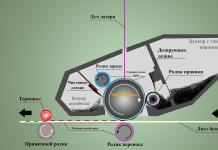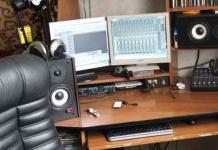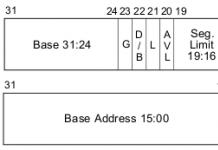In fact, the main idea of this educational program was to be a competent choice of acoustics. But when I got to work, I realized that it was logical to start with the very first problem - the sound properties of the room where this acoustics will stand. As a result, it turned out that this time I didn’t get to the speaker selection process, but I wrote some useful tips on where and how to install an already purchased system in order to reveal its best properties. I must say right away that the material is designed for beginner music lovers who are just taking their first steps in search of the best sound.
Judge for yourself: interesting advanced sources, amplifiers and speakers appear almost continuously, so there is always a temptation to try something new. Well, if the choice of a component suddenly turned out to be not very successful, the search for a replacement candidate from painful inevitability almost always turns into an additional adventure. On the other hand, the chance to choose a new room for a music system or home theater is very rare for most of us, for some - never at all.
For this reason, the fever of a permanent upgrade to the listening room, as a rule, does not apply. But it is precisely this that is the most important component of a sound installation, on which the character and sound quality of equipment, regardless of its class, most dramatically depend. Well, if so, there is only one option left: to leave the buying passion for a while and start bringing the existing property into acoustic order.
Prevention is better, but treatment is more common
Employees of Hi-Fi salons will not let you lie, the phrase "You played, but it doesn't play at my house" is the best illustration of the problem of interior acoustics. That is, acoustics itself has no problems, but they appear for those who try to ignore its existence.
Suppose a young family has found its own apartment. The first step is to draw up a plan for the arrangement and repair. "We'll put a fridge here, a washing machine in the bathroom, and a sofa in the living room." We hang the TV in front of the sofa, unless, of course, someone has the disastrous idea of driving it into a corner. Then, by the way, it may well turn out that the screen was opposite the window looking south - I personally saw this more than once.
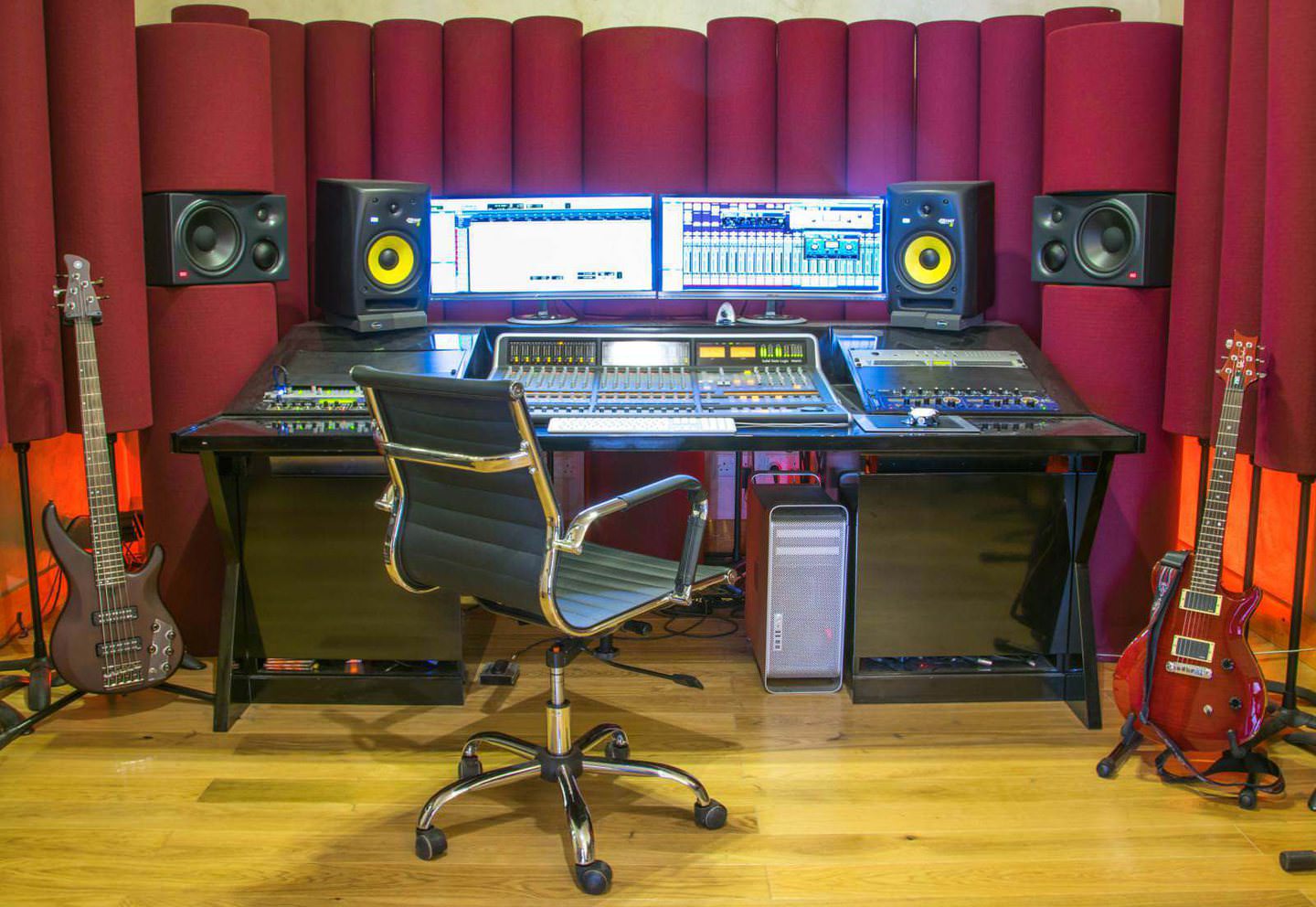 For the sake of uncompromisingly combating early reflections, optimizing bass and reducing reverb time, some home studio owners resort to the most drastic measures, such as building walls of acoustic traps.
For the sake of uncompromisingly combating early reflections, optimizing bass and reducing reverb time, some home studio owners resort to the most drastic measures, such as building walls of acoustic traps. Speakers are most often remembered last, and God forbid if this happens at least before the installation of the notorious sofa. It’s clear why: even if the future inhabitants of the apartment really like to listen to music, worries and expenses during a large-scale renovation above the roof, then they wouldn’t forget to order a toilet bowl ...
The outcome is predictable. The speakers are driven into the corners of the room, and the subwoofer peeks out from somewhere behind the curtain. As a result, the sound is likely to be worthy of the first car of a young fan of hip-hop, experiencing an acute shortage of funds and musical taste.
But purely by chance, arranging the acoustics so that your mother-in-law, a hereditary musicologist, when she comes to visit, plunges into deep euphoria, will never work. The fact is that the rules for the optimal location of sound sources almost always run counter to the established norms (not to say clichés) of interior design.
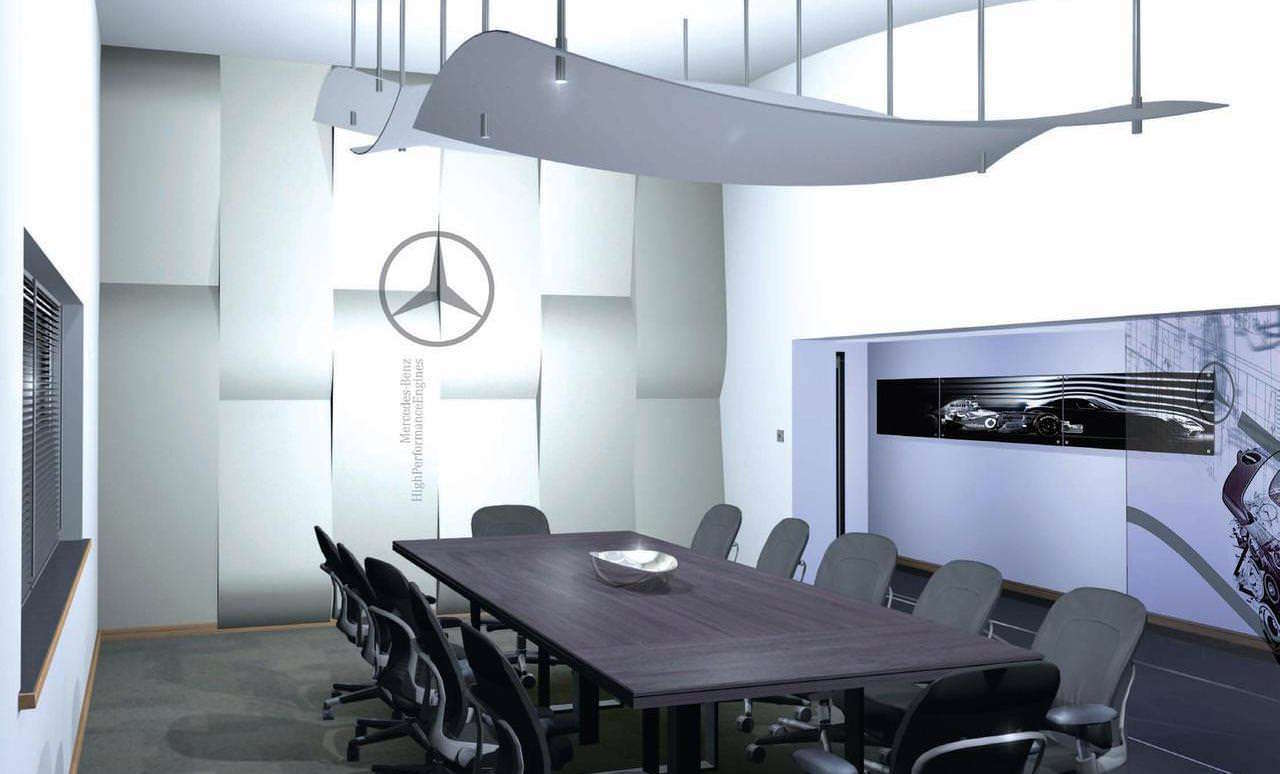 The fact that the acoustics of the room affects a lot, says, for example, the profile of the work of the British company Oscar Acoustics. They make a special design in the meeting rooms of offices, which improves the intelligibility of the speech of all participants in the meeting.
The fact that the acoustics of the room affects a lot, says, for example, the profile of the work of the British company Oscar Acoustics. They make a special design in the meeting rooms of offices, which improves the intelligibility of the speech of all participants in the meeting. It is important to understand that any room always works as a resonator, forming the character of the sound no less than, say, a violin soundboard. However, unlike the body of the violin, the shape of the room in the overwhelming majority of cases does not contribute to harmony.
For example, a rectangular topology with large parallel surfaces inevitably leads to unwanted reflections and standing waves, turning a more or less flat (at best) loudspeaker frequency response into a curve that most closely resembles an earthquake seismogram. Moreover, at different points in space, the shape of this curve can change in the most bizarre way.
Four bad rooms
We list the main factors of the negative impact of the room on the sound:
1. Insufficient, or, conversely, too long reverberation time. This parameter characterizes the "sonority" of the room, that is, the duration of the attenuation of the sound, and is expressed by the time required for its attenuation by a thousand times (by 60 dB). A room that is too noisy is just as unsuitable for normal perception of music as an absolutely deaf room, depriving listeners of the slightest sense of spatial volume.
2. Standing sound waves. They arise due to reflections and mutual superpositions of low-frequency oscillations, the wavelengths of which are comparable to the size of the room. By ear, they are perceived as sharp rises and dips of bass at strictly defined points in space.
 Yes, yes, this is how it happens not only with conversations behind you, but also with sound reflections from acoustics in front of you.
Yes, yes, this is how it happens not only with conversations behind you, but also with sound reflections from acoustics in front of you. 3. Early reflections. High-frequency (to a lesser extent - mid-frequency) vibrations reflected from surfaces located near the speakers (mainly bare side walls, floors and ceilings). They enter our ears almost simultaneously with the direct signal, disrupting the correct perception of the localization of sound sources in the stereo panorama. Moreover, the mismatch of the phases of the direct and reflected waves (which also varies in frequency) leads to a sharp deterioration in the uniformity of the frequency response.
4. Fluttering echo. A series of fast repetitions of sound at certain frequencies that occurs when the speakers are located between two parallel, highly reflective surfaces.
Saving sound with improvised means
There are many ways to curb sonic anarchy, the most radical of which involve building an accurate acoustic model of a room by laser scanning it. It is highly desirable to think about acoustic preparation even at the initial stage of a major overhaul, and it is better to entrust it to a proven specialist. And it is the installer, and in no case the interior designer. Because the latter (unless, of course, he is not an audiophile at the same time) does not know that large areas of drywall absorb basses with amazing appetite, while mids and highs reflect with characteristic overtones. Or that an uncurtained glass wall is the embodied nightmare of any music lover with ears.
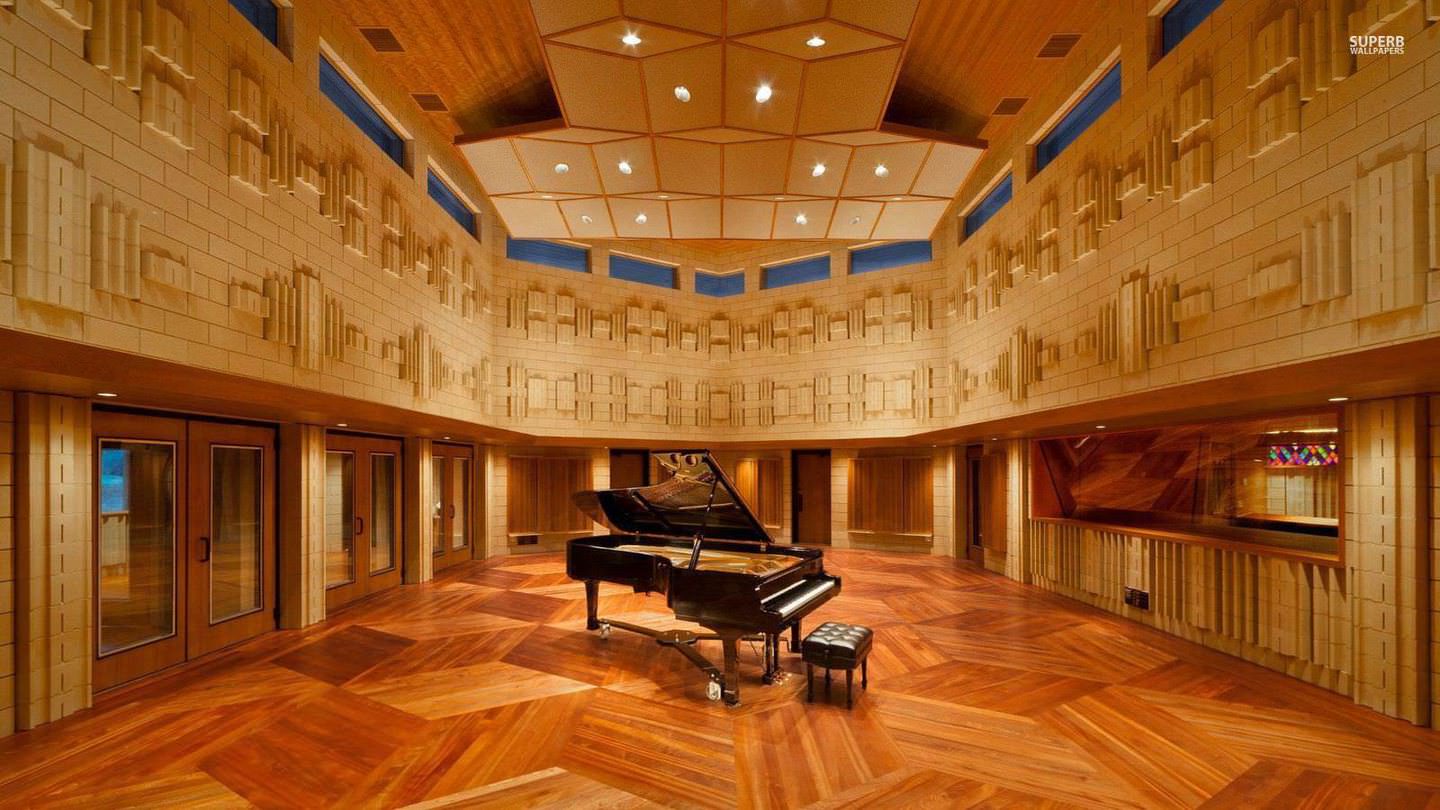 This is how the acoustic processing of one of the halls of the Manifold Recording studio looks like. This is to the question of how much work you need to invest in order for the room to sound for real.
This is how the acoustic processing of one of the halls of the Manifold Recording studio looks like. This is to the question of how much work you need to invest in order for the room to sound for real. However, if this train has already left, leaving the room with the existing decoration and interior as a given, you can try to improve its acoustic properties on your own. By the way, the chances of noticeably ennobling the sound of the system in this case are quite high. Of course, it will not be possible to completely get rid of all the problems, but on the other hand, it will be possible to save a lot of money in comparison with the “installer” option.
Let's start with a meaningful arrangement of columns. First of all, move them away from the back wall, especially if the phase inverter ports are directed just at it. This will make the bass less booming and more legible, and improve the depth of the music scene. How much to move? There is no one-size-fits-all answer, so read your speaker manual first, then listen and experiment. The listener himself, by the way, for the same reason, should not rest his head against the wall. Soft pillows on the back of the sofa help well, and ideally, a woven tapestry or a heavy curtain behind the back.
The proximity of the side walls contributes to the appearance of early reflections and standing waves, so we also try to keep the acoustics away from them. In the fight against the latter, by the way, it is very useful to obtain detailed information about the modes - that is, the frequencies at which resonant phenomena occur, at the same time finding out their approximate location in the room. To do this, you only need a tape measure and an online acoustic calculator, for example, this one.
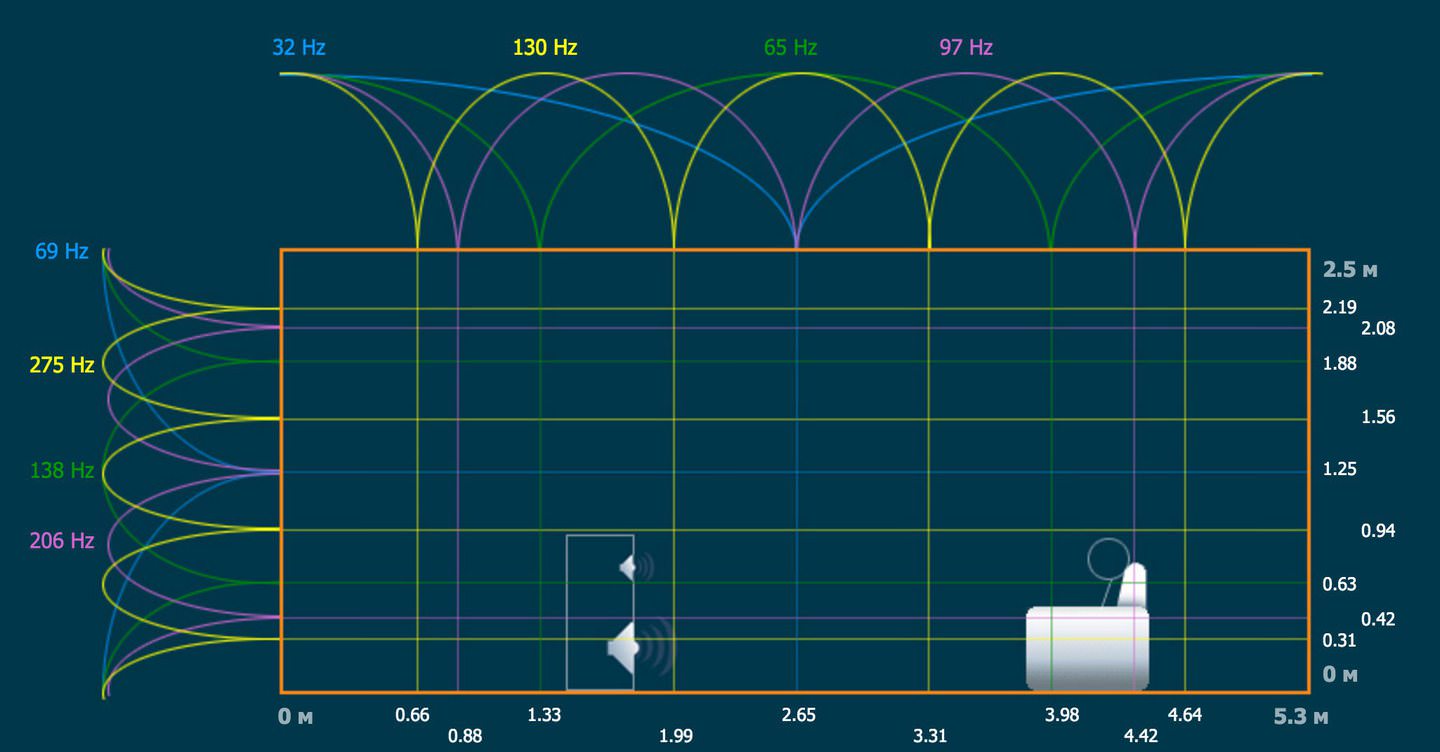 Acoustically Calculator
Acoustically Calculator Another way to determine the optimal position of the columns is the method of even and odd sections. For example, the length of a room is divided by an even factor, and the width by an odd factor. Dividing, say, the width by two, and the length by three, we get a kind of markup, at the intersections of the lines of which it is recommended to install speakers.
True, if the music lover does not live alone, at this moment it is extremely likely that a conflict situation will arise with household members who do not consider it a good idea to install two one and a half meter wooden pillars right in the middle of the room. Well, apparently we will have to make compromises, the main thing is that they, again, be meaningful from the point of view of acoustics. And keep in mind that as the distance between the speakers decreases, the upper part of the bass spectrum, as a rule, begins to sound brighter, and the deepest lows - vice versa. Also, always try to minimize the length of the wires connecting the speakers to the final amplifier. Most likely, for this you will have to lengthen the interconnects, but the game is worth the candle.
After the speakers have found a stable position in space, orient their acoustic axis directly to the listening position. Any deviation from the "direct shot" is fraught with distortion of the frequency response, especially at high frequencies, because the developers strive to get the best sound for just such a position of the emitters. True, some manufacturers (for example, Dali for speakers with broadband ribbon tweeters) recommend not to deploy them to the listener, but this exception only confirms the general rule. In the version with shelf speakers, for the same reasons, the HF emitters of the speakers should be at the level of the ear of a seated person.
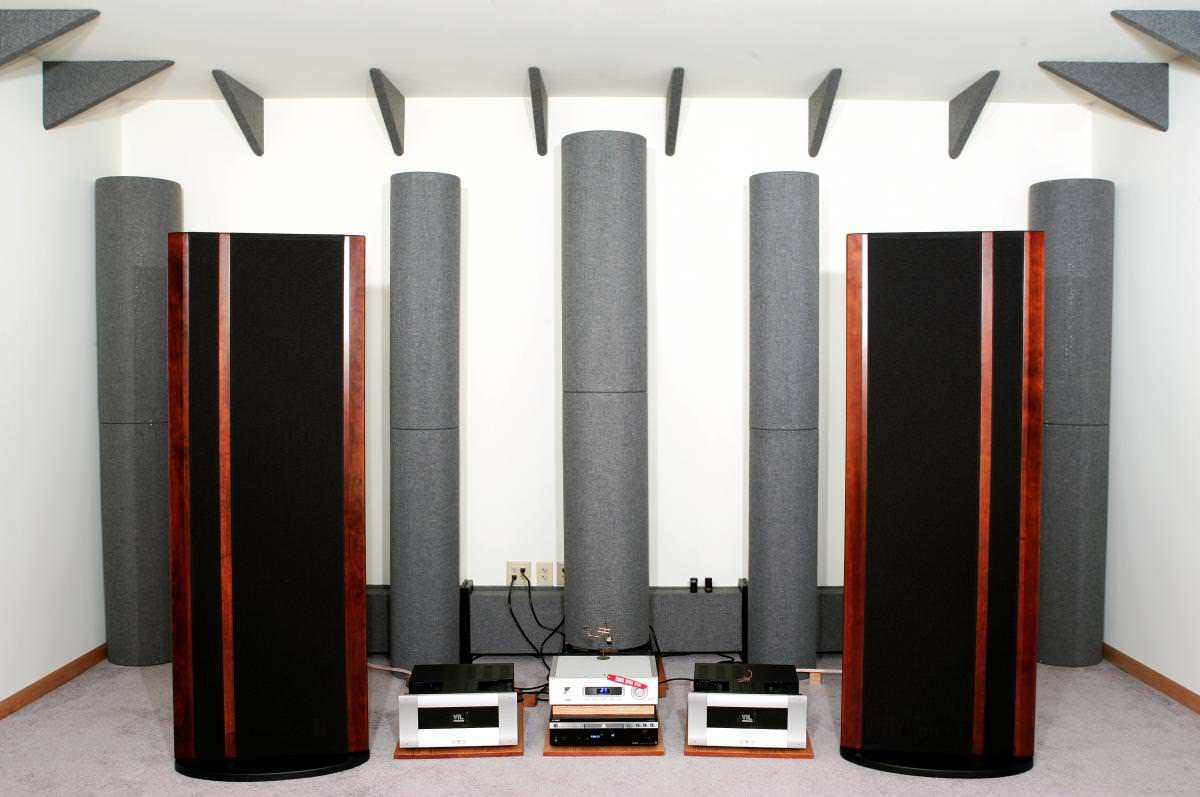 Walls and ceilings that converge at right angles are the main acoustic problem in most rooms. Large acoustic traps will help even in the most difficult cases, the main thing is to be able to fit them into the interior
Walls and ceilings that converge at right angles are the main acoustic problem in most rooms. Large acoustic traps will help even in the most difficult cases, the main thing is to be able to fit them into the interior If we are talking about a 2.1 configuration (we will consider multi-channel systems for home cinema in a separate article), it's time to deal with the subwoofer. With a decrease in the frequency of the sound, the direction of its propagation decreases, but this does not mean at all that the sub can be pushed anywhere - as long as it does not interfere and there are enough wires.
Individual for each room set of modes and potential sources of resonances (glazed cabinet with dishes) makes finding the optimal subwoofer location exciting, creative and far from easy. Feel free to experiment with its position - and you will be surprised how different "non-directional" low frequencies can sound.
In order not to carry a heavy box during the experiments, some do the opposite: they put the sub in a chair, and in search of the right bass (not louder, but more legible and uniform) they crawl around the room on all fours, and then they put it in the best listening place sub. We already know the starting point in the search: closer to the walls and corners - more bass, and, most often, uncontrollable rumble. By the way, in the process of moving, do not forget about adjusting the cutoff frequency and phase rotation, it also helps.
About the benefits of mirrors and the dangers of reflections
During all manipulations with acoustic systems, it is important to remember that the biggest troubles are usually caused by well-reflecting surfaces of a large area, especially when they are located symmetrically. That is why recording studios and high-class concert halls do not have right angles and parallel walls, and their ceilings are formed by panels of complex shape, which work, depending on the specific task, to absorb or dissipate sound energy.
For our situation, "setting up a room" can involve three steps. First, we determine the reverb level (the easiest way is to clap your hands loudly and listen carefully to the reaction of the room). Too sonorous rooms are much more common than muffled ones. Any sound-absorbing materials and objects will fit for adjustment: upholstered furniture, thick curtains, paintings and bookshelves on the walls (by no means glazed), and even large plush toys. If the sound from cotton disappears almost before you bring your palms together, then there is a clear overkill with the elements of decoration and comfort, and it would be nice to get rid of some of them.
Stage two - the fight against early reflections. The carpet on the floor helps a lot here (the thicker the better), and the ceiling, lined with sound-absorbing tiles (tension fabric also works great). A compromise option: a decorative rug directly in front of the speakers. Do not forget about the walls, instead of paintings, it is better to place special sound-absorbing panels on them, some of which look quite stylish and pretty. It is not difficult to find the optimal place for the placement of absorbing elements. Attach a mirror or a sheet of mirror film to the surface under study and move it until the person sitting in the listening position sees the reflection of the speakers in it. Well, since the angle of incidence is equal to the angle of reflection, it is in this area that the sound-absorbing material must be placed.
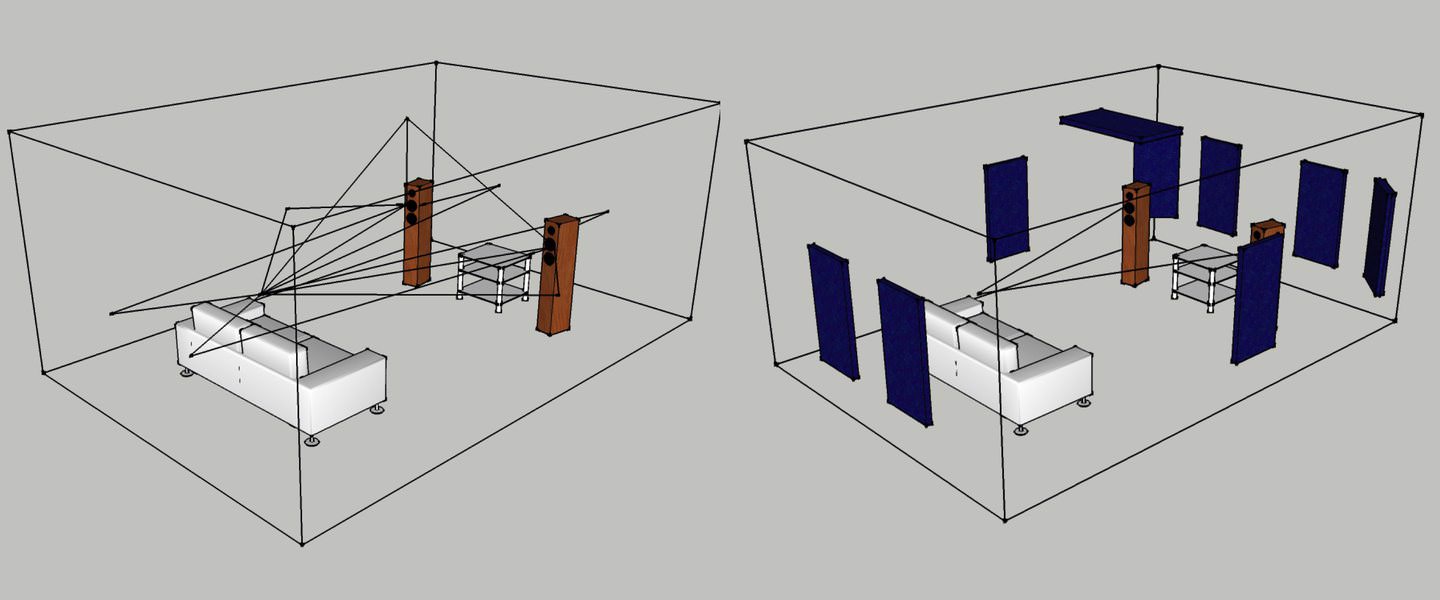 An example of effective placement of sound-absorbing panels
An example of effective placement of sound-absorbing panels In the finale, a few more words about the taming of basses. An effective way to deal with their excess, uneven distribution and characteristic mumbling is to place acoustic traps in the corners (sometimes along the walls too) - cylindrical structures that absorb the energy of low-frequency vibrations. To install them, you don’t have to start repairs, but you need to be mentally prepared for the appearance of several more bulky objects in the room.

























